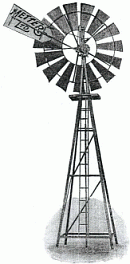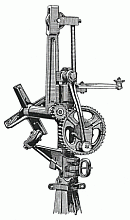


The METTERS TOFF windmill was first marketed about 1909, but the earliest record held by our archives is for 1912, when it was offered with 6 & 7 foot wind wheels on 6.1 and 9.1 metre towers and with the option of a stub tower. By 1920 the mill was offered with 6, 7, 8 and 9 foot wind wheels with the same size towers. It was still on offer in 1935, but only with 6 and 7 foot wind wheels. The towers offered then included the original sizes in painted or galvanised towers, plus a 7.5 metre painted tower. The TOFF did not appear in 1939 price lists.
There were 4 spokes and 16 blades for the 6 & 7 foot mills, 4 spokes and 12 blades for the 8 foot model, and 5 spokes and 15 blades for the 9 foot model.
Even forgetting competition from other brands such as AERMOTOR and ALSTON, this open geared mill had competed since 1919 with METTERS' own range of oilbath windmills, starting with the NUOIL windmill and later the MASTER NUOIL windmill. Both those mills were considerably dearer than the TOFF and gave it an advantage on that ground. However, from 1934 it was competing directly with the METTERS MODEL K windmill, and in that match up was disadvantaged in both price and pumping performance. This made it a relatively expensive windmill but it was also, as can be seen by the exhibit, a strongly built mill.

This windmill is unusual in that it used angle iron lengths for spokes, and this led to a wind wheel design using a curved flat bar for the inner ring which bolted onto the side of the spoke, and a conventional outer rim. The main casting seems to be common to all the wind wheel sizes and probably the tail was also changed.

There were some design variations during the life of the TOFF windmill, but these appear to be minor. The length of the tail buffer section of the main casting in the furled position, appears to have about three variations and in the earliest models the sheave carrier arm was integral with the main casting. The arrangement of grease cups for the hub shaft also changed. The assumption being that this version, with both grease cups on top of the nose section is the earlier form, and the version with the rear cup shifted to the side of the main casting and closer to the back end of the bearing, is the later version. Earlier versions such as this one, also had a grease cover fitted to the main gear with three countersunk screws. This protected the end of the shaft and was actually a part from the 1914 Model, METTERS WINDMOTOR windmill [Note a 'W' parts mark on the gear]. This fact, plus the knowledge that it is a pre 1923 model, gives a rough indication of the age of this particular mill.
The TOFF on display at the museum is the second of about four types of main casting made up to about 1920. The drawing of the head is Type 1 and probably was made from c1909 to c1915. Note the sheave arm is cast integral with the main casting and in the museum example it is a separate casting.